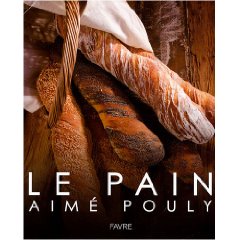
One Very Successful Swiss Bread: the Paillasse (its story and an attempt of making it at home)
Every time I spend five, six weeks with my family in Switzerland in summer, this is the bread I am looking forward to eating the most.

It is originally from Geneva (the French-speaking part of Switzerland) and its inventor is Aimé Pouly, the author of the book “Le pain” (available, but out of stock right now at Amazon, only in French, as far as I know).



He is one of the originators of the “Slow Baking” movement, where bread dough is made completely without the too commonly used industrial flour mixtures that speed up the fermentation. Most bakeries have everything but time, it has to be fast and cheap, and the lacking taste is being helped with additives – a very common approach nowadays, as the well-known German baker Süpke (referred to recently by Hans Joakim) explains in this very interesting article about preferments (in German though). He says, that until he discovered the Slow Baking movement, the only preferment he’d use in his bakery was sourdough. All other dough was made with the use of “little helpers” or convenience additives, as most bakeries do. Now, he says, he doesn’t sell a single bread with yeast that has not gone through some type of prefermentation, and the change was everything but easy, he adds. The entire rhythm of the bakery changed completely, but the resulting breads were absolutely worth it.
Aimé Pouly believes in the old approach of a very long fermentation (about 24 hours it seems) and all breads are hand-formed and therefore no two of them are the same. This is the first fresh bread recipe worldwide that got patented, in 1995. Since then, every bakery that wants to sell this bread needs to get the license from Pouly, and apparently only good, quality bakers are able to get it. Then an advisor comes into the bakery to teach the bakers. MANY bakeries in Switzerland now sell the Pain Paillasse, and in the meantime also over 50 bakeries in Germany, and many places in France, Spain, Austria, Italy, and probably more, but the flour will always get delivered to all of them from Switzerland, as part of the recipe. A true success story of slowness, as it is sometimes referred to.
It originally came in three types: white, dark, and rustique (with seeds), but now also with olives, or chocolate, as a provençal version, and more.

The crust is strong, and the crumb is very open, soft, sweet (there is, however, no sweetness added, it’s just the long fermentation) and very moist.

The taste is just wonderful! My favorite one is the rustic one with the seeds.

Since the recipe is a secret, I have recently tried to recreate a version of it. I saw a recipe for Alpine Baguettes in the blog Beginning With Bread. It is from Daniel Leader’s book “Local Breads” and he got it from Clemens Walch in the Austrian Alps. Since I liked the outcome so much, I have now purchased the book and intend to try many more recipes from it.
We really loved this bread! I have made it twice now, the first time with a whole-wheat starter and the second time completely according to the recipe, with a rye starter (that I have changed from my AP starter over the course of three or four feedings). I could not, however, detect a really different flavor or behavior of the dough, thus in the future I will just take my WW starter. If you like breads studded with seeds (it contains a soaker of sunflower, pumpkin, flax and sesame seeds, as well as rolled oats), then give this a try!
This was my outcome:

The Paillasse rustique has most of its seeds on the outside (it specifies this on the paper sleeve in which it is being sold), the inside just has a few and is otherwise mostly like the dark Paillasse. The Alpine Baguettes are full of seeds inside, but since the hydration is quite high, it's not easy turning the final loafs in a mixture of seeds and grains to coat them.


Comments
This looks very nice chouette22. I haven't read your method but it looks like you are twisting the dough. I'll have to give this a try.
Eric
Thanks Eric. Yes, after forming the baguettes, you twist the dough. I like the shape of it, but another reason for it is, I assume, that it must be giving the loaves a bit of strength and tension as well, since the dough is quite slack.
I love the twisted look of the loaf!
"It originally came in three types: white, dark, and rustique (with seeds), but now also with olives, or chocolate, as a provençal version, and more.
What is hanging out of the loaf above?
Betty
from these short, individual loaves is chocolate. I have not tasted these, but when growing up, a special treat for us kids was often a piece of hearty bread in one hand and two or three squares of milk chocolate in the other. This Paillasse must taste just like that.
Chouette, good work! the Alpine baguette Recipe has already been on my to do list for several weeks. I really should try it! Looks very delicious.
I don't know if you've read about this, but the saga behind the Pain Pailasse is that a dough got actually "forgotten" in a bakery and that it stood outside at room temperature for about 24 hours, so I think the "original" recipe doesn't include sourdough. the final fermentation is just extremely long. I wonder how that works. Anyway. Your attempt looks great and I don't mind how a great bread is called . . . Pain Pailasse, Wurzelbrot, blablabla. ;)
I just had a look at Backer Süpke's article about preferments and I think that I'll give his Wurzelbrot a try!
Salome
... funny how some great recipes come about. And that Wurzelbrot is on my list as well. I looked up the 1050 type flour and believe it's a high gluten flour. I need to get that first (for some other breads too that need that ingredient). We'll compare notes once we get them baked.
Great job on your interpretation of the Pain Paillassa! I can identify with your passion of trying to recreate unforgettable food items that you have tasted. Aime Pouly's franchising his Pain Paillasse is very similar to what Bernard Ganachaud is doing with his "La Flute Gana". For a licensing fee, he would train a boulanger to duplicate his signature baguette and produce it under license.
Don
- I hadn't heard of "La flute Gana". I just looked it up and it seems also that at the bakery with the same name, you can buy some of the best croissants in Paris.
Hi chouette22
This is a very interesting post. Thank you. I didn't know bread can be patened. I bought the French book a while ago based on the front cover picture and am very happy with it. I made the twisted baguette (fortunately I just called it "baguette") and found the shape really attractive. It's very tricky to handle. I find the twisting shape is more defined (from baking) when the dough is first rolled on plenty of flour before being twisted then proof.
Thank you for your post.
... reading in your blog that you had Aime Pouly's book. I'd love to take a look at it as well. I'll have to wait until it is available again at Amazon or maybe I'll find it at another site.
at www.renaud-bray.com a bookstore in Montreal specializing in French books.
Don
Thanks Don for letting me know.
I have been to the Confederation Helvetica many times ...maybe 15 to 20 times. I did not count. Where do you find this bread? I have been to Geneve and much of both the french and german speaking parts but do not recall spotting this particular bread? I have not been to the southern area that is influenced by the Italians, nor the eastern parts nearer Austria however. My wife and I will be returning to Switzerland for our 10th anniversary before too long ...it would be nice to find what you have also discovered!
Brian
...as Salome has already pointed out in the post below, there are MANY bakeries all over Switzerland selling the Paillasse, but certainly not all of them. As you see from my post, every bakery selling this particular bread needs to get the license to make it, and not every bakery does that of course. You'll just have to ask. Since there is a bakery at pretty much every corner in CH, you'll easily find it. In Geneva itself, I have read that over 50 bakeries are selling it by now.
Wow, you certainly have been to Switzerland many times! Do you have family there or travel there for business or just like it?
Thanks. I ate so many good things in Switzerland that it's hard to remember them all ...I really love the Swiss cuisine. My wife and I will be returning in a couple of years for our 10th anniversary, so I'll have to look for the Paillasse a little more carefully on that trip!
And in answer to your question, my trips were mostly for business, and mostly to La Chaux-de-Fonds where one particular company there was building custom high-volume manufacturing equipment for us. Company policy allowed us to fly first class on our 4th and higher trip overseas in any 12 month period (rolling window) ...but first class was so much more expensive that our management made a deal with us. If we flew coach, then we could stay longer, personal vacation in Switzerland without having to claim vacation days, and they would cover the costs. It saved the company money and allowed us to travel around Switzerland and surrounding countries for free. Ahhhh ...the good ol' days! I miss it and am looking forward to coming back as soon as I can.
Brian
1050 is high extraction flour. meaning, it's not actually white flour, some parts of the outer shells of the grain are still included. In Switzerland it's called Ruchmehl. it's not high gluten flour.
the pain pailasse can be found in all german speaking parts of switzerland, as far as I know. but of course not in every bakery! german speaking switzerland, that's where I live. I would expect it "down there" in Geneva as well though.
Salome
I must have made a mistake when looking this up. I am glad you pointed that out. If I mix bread flour with whole-wheat, do you think I get something close to Ruchmehl?
yes, you get something similar. not exactly the same of course, but you will get a flour that is in between white and whole grain flour. ;)
If you're really serious about this 1050 flour thing, you can order high extraction flour at king arthurs, as far as I know. But - I've never seen or touched king arthurs high extraction flour, so I can't promise you that it's actually closer to 1050 flour than just a WW/white flour blend. ;)
Salome
As far as I know, KAF does not sell a high extraction flour. I wish they did!
David
That takes care of having to look it up and digging through their catalogue.